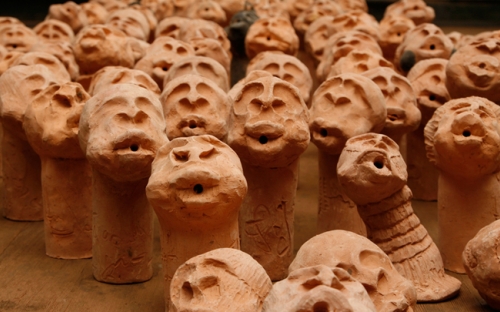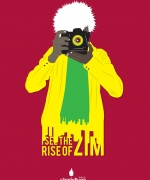A time to Project and Pro-Act new images, sounds and Narratives? Black Detroit
I come from a school of thought that people gravitate towards that which is constantly projected before them. The Zezuru people in Zimbabwean culture as in most cultures on the Afrikan Continent are primarily and a profoundly visual people. A greater percentage of communication patterns including the symbol, metaphor and proverb have root in the visual aspect of life. My time in Detroit has been filled with wonder, comparison and learning. The word “Alive” best describes the Detroit art scene. I have a special interest in Black Detroit not only because I’m Afrikan but because the Black American story is yet to be fully told and owned by its own people…but how do you own a future story?
“Until Lions have their own historians, Tales of the hunt will always glorify the Hunter”
African Proverb
Today I would however augment the meaning of the word historians and replace it with projectionists. Projectionists function in the office of “Prophets” they observe the times and study history but are neither preoccupied by the present or the past. Instead they liberate themselves from the constraints of the afore mentioned definitions of time and they create and nurture fragile future Images, sounds ideas and atmospheres hoping that their own people will grow to become those images. I have deep respect for Afrikan American people. This particular group of people have had to fight harder for the right to “being” and continue rightly so in the face of atrocious racial vices and apparatus in their environments. The struggle today is in place that’s both beautiful and critical in that Afrikan American artists in history have managed to ground and locate black people in the reality of their circumstance and more so to challenge and respond to stereotypes and constructs associated with the Afrikan American in this country especially the Afrikan American male species.
May I submit to you the following opinion: Art is as powerful or as relevant a tool as the intentions of the person(s) who owns it? In Zezuru cosmology we have a proverb that says “Chisichako masimba mashoma” which means you only claim power of definition over that which you own. This is why repatriation processes must continue for the ancestral works of art stolen from the Afrikan continent. Vices such as illicit trafficking of cultural objects must be challenged with retroactive instruments that will allow Afrikans and indigenous peoples and all over the world to take back their art from former colonisers or pillagers of the meme (cultural gene), heritage and art. In this context I would like to encourage continuation of the notion of growing and cultivating Afrikan American collectors of contemporary Afrikan American art. It is still questionable to have other groups of people as major collectors and presenters of such important Afrikan American exhibitions such as 30 American Voices. I do not advocate for separation or segregation of any race especially in the art world which is a space we all share . I however think that Afrikans and Afrikan Americans committed to projecting and pro-acting new narratives and images of their own people need to reflect on the fact that art is a tool and is only powerful as the intentions of the one who owns it. Perhaps this is the time for us to de-perpetuate the idea of the Afrikan as the producer of cultural goods and think of him as the consumer and proprietor of these bodies of cultural knowledge. The absence of black consumption balance in art tends to perpetuate the emasculation of powerful black narratives and images. I admire the work of Dr Charles Wright in building a legacy of history for the African American community in Detroit. The work of Dr George N’namdi cannot go unnoticed as a positive development and hope for cultivating more Afrikan American collectors of contemporary art.
As much as art can be commodified I’m of the opinion that it is irresponsibly dangerous for Afrikans and Afrikan Americans to yield ownership of their artistic expressions to other groups of people especially to former colonisers and former enslavers. This is because in early Afrika colonisers made it a point to loot cultural objects and the art of Afrikan communities and proceeded to use them as objects of inquiry to study the Afrikan meme (cultural gene) and also to selectively represent images that served their best interest. When Cecil John Rhodes led the Pioneer Column in 1890 to annex the Region of Mashonaland in Zimbabwe he made a point to loot the best articles of creative and cultural significance as a means of studying the indigenous people to arm himself with subtle cultural information for the future success of the colonial machinery. The Afrikan continent today is still battling with issues of neo-colonialism and cultural hegemony because of loss of critical cultural information which has either been hidden from them or misappropriated. The afore mentioned vices are made successful because of cultural products that are designed to psychologically distort and gentrify black culture and most of these products are delivered through instruments such as television and other mediums. Several reports say that black and minority children watch more television than any other groups of people in America (the same can be said about Afrika). This could rightly be termed “psychological gentrification” a word coined by Dr. George N’namdi in 2005. This is possible because neo-colonial cultural designers use intricate cultural information gleaned from stolen and museumised memes to create counter products that psychologically gentrify targeted groups of indigenous people. The question is how are these groups of people responding to this state of affairs? Recent studies show that Afrikan Americans consume more television products than any other group in America. It is observed that marketers and advertisers spend $ 75 billion on television only $ 2.24 billion of that sum is invested towards media focused on black people. Clearly there is need to create critical cultural content and appetite for black audiences.
The million dollar question can be phrased as follows: Do Afrikans on the continent and in diaspora understand the times that we are in at the present moment? Is this the time of imprisoning ourselves in the negativity of our times, or a time of reacting to negative stereotypes and constructs that has been presented before us? I strongly believe this is a time to project and pro-act what we want to become. Maybe a time to interrogate labels even self-imposed ones too, sometimes I feel that the “black label/brand” has been used so much in protest art and movements such that it has morphed into an albatross that has diverted our attention from more important things. In Zezuru we have a proverb that says “Haikona kupedzera museve kunana dhimba, hanga dzichauya” it simply means do not waste your arrows on smaller prey because the lager prey will come, its only a matter of time. Everything around us confirms that this is the time of projection and pro-action for black Detroit and black people around the world. We cannot afford the cost of forgetting history neither can we be naïve about the here and now, but at the same time we must invest more in the aspect of history that speaks of a victorious heritage and legacy and above all project the future. My heart sank when I encountered the slave ship section in the Charles Wright Museum of Afrikan American History. I wasn’t saddened because my people where dehumanised by the vice of slavery but I was sad that my people chose to invest more resources in projecting a part of the story that details defeat more than they invested in other narratives of victory in the same story.
Why not invest more resources and attention in victorious narratives such as the 1811 slave rebellion of Louisiana, The Amistad rebellion led by Cinque, the Creole Rebellion in the early 1840’s. Black American history does not fall short of Heroes talk of Fredrick Douglass, Harriet Taubman, and Gaspar Yangar of Veracruz. Why not build and recreate larger than life narratives around these heroes? Countless other heroic stories live on the African continent which are at the disposal of Afrikans in the Diaspora. There is a need to de-perpetuate the selective apparatus that has focus fixed on negative portrayal of black people. I admire the work of Kehinde Wiley for addressing some of these issues at the right time around the early 2000 ‘s. I have respect for Tyree Guyton for grounding people in their present reality of demise in the late 1980’s. I respect the work of Nick Cave for realizing the need of our current times and projecting new images pro-acting important processes and directly borrowing ideas from the Afrikan continent around dance ritual and costumage and translating these to a wider audience. This time on the Afrikan psycho-social and political calendar is a time to consider Marx, Brecht and Mayakovski’s beliefs that art is not a mirror to hold up to reality, but a hammer with which to shape it.
Masimba Hwati is a Zimbabwean artist, known for unconventional three-dimensional mixed media sculptures. Hwati studied at the Harare Polytechnic from 2001 to 2003 where he majored in Ceramics and Painting he currently teaches Drawing and Sculpture at Harare Polytechnic. His work explores the transformation and evolution of knowledge systems that are indigenous to his own background whilst experimenting with the symbolism and perceptions attached to cultural objects, expressed as an art movement known as "The Energy of Objects”. His current work juxtaposes intense cultural objects and symbols with trivia and seemingly ephemeral mainstream symbols and Icons. His works use contemporary and historical themes. He also works extensively with found objects, transforming existing artifacts into antennas and gadgets of memory. His research grows around exploration of postcolonial themes by re-appropriating archives and objects and presenting them in new contexts. With an emphasis on sculptural work, Hwati collects historical, culturally imbued items ranging from cars and shoes, to scrap metal and found objects, altering and repositioning them in a contemporary urban setting. His work has been shown in place like Germany, France, Canada, and London, The United states of America, Australia and southern Africa. In 2015 he represented his country at the 56th edition of the Venice Biennale in Italy. Masimba has worked and researched in Places like Capetown, Avignon France, Nova Scotia Halifax, Detroit Michigan, he is currently a Resident Artist at Zimbabwe Cultural Center of Detroit working at Popps Packing in Hamtramck.
References:
Zezuru-A Clan found predominantly in northern region of the Southern African country of Zimbabwe, the majority ethnic group in Zimbabwe
Afrikan-adopting this spelling is a conscious and rebellious reference to an Afrika free of slavery, Colonization and hegemonic frames of reference.
“Until Lions have their own historians, Tales of the hunt will always glorify the Hunter”: African Proverb (Igbo) –Believed to have come from the Igbo tribe in Nigeria, The Igbo are an ethnic group of southeastern Nigeria.
“Chisichako Masimba mashoma” shona proverb-Directly translated you have limited power over those things that you don’t own
D.I.A-Detroit Institute of the Arts Address: 5200 Woodward Ave, Detroit, MI 48202, United States
30 American Voices – 30 Americans showcases works by many of the most important African American artists of the last three decades. This provocative exhibition focuses on issues of racial, sexual, and historical identity in contemporary culture while exploring the powerful influence of artistic legacy and community across generations. Recently a travelling exhibition shown in some City Galleries in the United States at The Detroit Institute of the Arts
Afrofuturism- is a literary and cultural aesthetic that combines elements of science fiction, historical fiction, fantasy, Afrocentricity, and magic realism with non-Western cosmologies in order to critique not only the present-day dilemmas of people of color, but also to revise, interrogate, and re-examine the historical events of the past. First coined by Mark Dery in 1993 in his Essay Black to the future.
Dr Charles Wright Museum of African American History Address: 315 E Warren Ave, Detroit, MI 48202, United States
Dr George N’namdi- G R N’namdi Gallery Address: 52 E Forest Ave, Detroit, MI 48201, United States
Cecil John Rhodes - Cecil John Rhodes born 5 July 1853 -died 26 March 1902 was a British colonial-era businessman, mining magnate, and politician in South Africa. An ardent believer in British colonialism, Rhodes was the founder of the southern African territory of Rhodesia (now Zimbabwe and Zambia), which was named after him in 1895.
Tyree Guyton - Tyree Guyton is an artist from Detroit, Michigan. Cofounder of the Heidelberg Project in Detroit east side .
Nick Cave - Nick Cave is an American fabric sculptor, dancer, and performance artist. He is best known for his Sound suits: wearable fabric sculptures that are bright, whimsical, and other-worldly
Karl Marx - was a German philosopher, economist, communist, sociologist, journalist and revolutionary socialist.
Bertolt Brecht - was a German poet, playwright, and theatre director of the 20th century
Vladimir Vladimiroviç Mayakovski was the leading Russian Futurist poet of the 20th century who created an entirely new form of Russian





